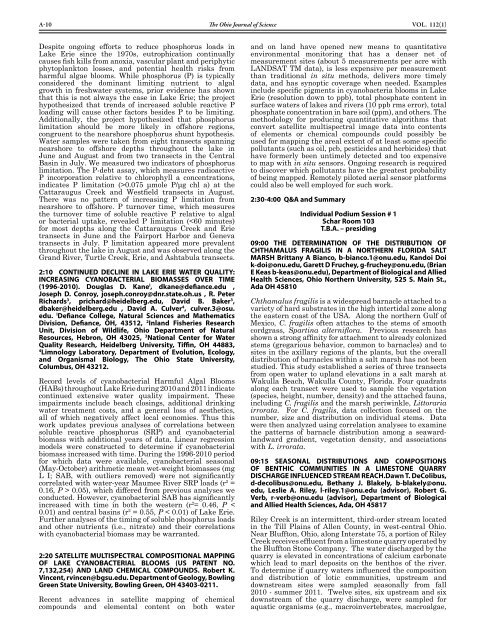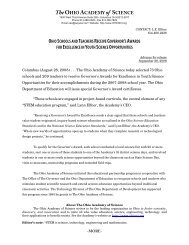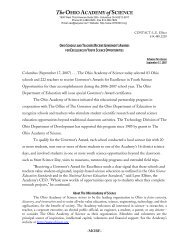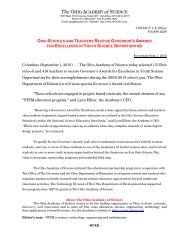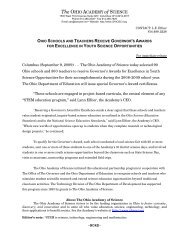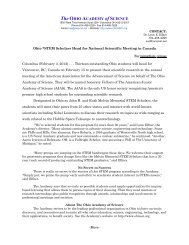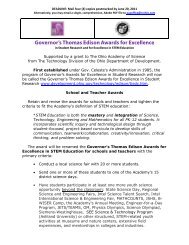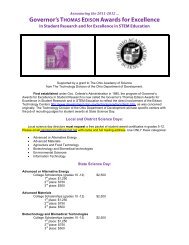The Ohio Journal of - The Ohio Academy of Science
The Ohio Journal of - The Ohio Academy of Science
The Ohio Journal of - The Ohio Academy of Science
You also want an ePaper? Increase the reach of your titles
YUMPU automatically turns print PDFs into web optimized ePapers that Google loves.
A-10 <strong>The</strong> <strong>Ohio</strong> <strong>Journal</strong> <strong>of</strong> <strong>Science</strong><br />
Vol. 112(1)<br />
Despite ongoing efforts to reduce phosphorus loads in<br />
Lake Erie since the 1970s, eutrophication continually<br />
causes fish kills from anoxia, vascular plant and periphytic<br />
phytoplankton losses, and potential health risks from<br />
harmful algae blooms. While phosphorus (P) is typically<br />
considered the dominant limiting nutrient to algal<br />
growth in freshwater systems, prior evidence has shown<br />
that this is not always the case in Lake Erie; the project<br />
hypothesized that trends <strong>of</strong> increased soluble reactive P<br />
loading will cause other factors besides P to be limiting.<br />
Additionally, the project hypothesized that phosphorus<br />
limitation should be more likely in <strong>of</strong>fshore regions,<br />
congruent to the nearshore phosphorus shunt hypothesis.<br />
Water samples were taken from eight transects spanning<br />
nearshore to <strong>of</strong>fshore depths throughout the lake in<br />
June and August and from two transects in the Central<br />
Basin in July. We measured two indicators <strong>of</strong> phosphorus<br />
limitation. <strong>The</strong> P-debt assay, which measures radioactive<br />
P incorporation relative to chlorophyll a concentrations,<br />
indicates P limitation (>0.075 μmole P/μg chl a) at the<br />
Cattaraugus Creek and Westfield transects in August.<br />
<strong>The</strong>re was no pattern <strong>of</strong> increasing P limitation from<br />
nearshore to <strong>of</strong>fshore. P turnover time, which measures<br />
the turnover time <strong>of</strong> soluble reactive P relative to algal<br />
or bacterial uptake, revealed P limitation ( 0.05), which differed from previous analyses we<br />
conducted. However, cyanobacterial SAB has significantly<br />
increased with time in both the western (r 2 = 0.46, P <<br />
0.01) and central basins (r 2 = 0.55, P < 0.01) <strong>of</strong> Lake Erie.<br />
Further analyses <strong>of</strong> the timing <strong>of</strong> soluble phosphorus loads<br />
and other nutrients (i.e., nitrate) and their correlations<br />
with cyanobacterial biomass may be warranted.<br />
2:20 SATELLITE MULTISPECTRAL COMPOSITIONAL MAPPING<br />
OF LAKE CYANOBACTERIAL BLOOMS (US PATENT NO.<br />
7,132,254) AND LAND CHEMICAL COMPOUNDS. Robert K.<br />
Vincent, rvincen@bgsu.edu. Department <strong>of</strong> Geology, Bowling<br />
Green State University, Bowling Green, OH 43403-0211.<br />
Recent advances in satellite mapping <strong>of</strong> chemical<br />
compounds and elemental content on both water<br />
and on land have opened new means to quantitative<br />
environmental monitoring that has a denser net <strong>of</strong><br />
measurement sites (about 5 measurements per acre with<br />
LANDSAT TM data), is less expensive per measurement<br />
than traditional in situ methods, delivers more timely<br />
data, and has synoptic coverage when needed. Examples<br />
include specific pigments in cyanobacteria blooms in Lake<br />
Erie (resolution down to ppb), total phosphate content in<br />
surface waters <strong>of</strong> lakes and rivers (10 ppb rms error), total<br />
phosphate concentration in bare soil (ppm), and others. <strong>The</strong><br />
methodology for producing quantitative algorithms that<br />
convert satellite multispectral image data into contents<br />
<strong>of</strong> elements or chemical compounds could possibly be<br />
used for mapping the areal extent <strong>of</strong> at least some specific<br />
pollutants (such as oil, pcb, pesticides and herbicides) that<br />
have formerly been untimely detected and too expensive<br />
to map with in situ sensors. Ongoing research is required<br />
to discover which pollutants have the greatest probability<br />
<strong>of</strong> being mapped. Remotely piloted aerial sensor platforms<br />
could also be well employed for such work.<br />
2:30-4:00 Q&A and Summary<br />
Individual Podium Session # 1<br />
Schar Room 103<br />
T.B.A. – presiding<br />
09:00 THE DETERMINATION OF THE DISTRIBUTION OF<br />
CHTHAMALUS FRAGILIS IN A NORTHERN FLORIDA SALT<br />
MARSH Brittany A Bianco, b-bianco.1@onu.edu, Kandoi Doi<br />
k-doi@onu.edu, Garett D Fruchey, g-fruchey@onu.edu, (Brian<br />
E Keas b-keas@onu.edu), Department <strong>of</strong> Biological and Allied<br />
Health <strong>Science</strong>s, <strong>Ohio</strong> Northern University, 525 S. Main St.,<br />
Ada OH 45810<br />
Chthamalus fragilis is a widespread barnacle attached to a<br />
variety <strong>of</strong> hard substrates in the high intertidal zone along<br />
the eastern coast <strong>of</strong> the USA. Along the northern Gulf <strong>of</strong><br />
Mexico, C. fragilis <strong>of</strong>ten attaches to the stems <strong>of</strong> smooth<br />
cordgrass, Spartina alterniflora. Previous research has<br />
shown a strong affinity for attachment to already colonized<br />
stems (gregarious behavior, common to barnacles) and to<br />
sites in the axillary regions <strong>of</strong> the plants, but the overall<br />
distribution <strong>of</strong> barnacles within a salt marsh has not been<br />
studied. This study established a series <strong>of</strong> three transects<br />
from open water to upland elevations in a salt marsh at<br />
Wakulla Beach, Wakulla County, Florida. Four quadrats<br />
along each transect were used to sample the vegetation<br />
(species, height, number, density) and the attached fauna,<br />
including C. fragilis and the marsh periwinkle, Littoraria<br />
irrorata. For C. fragilis, data collection focused on the<br />
number, size and distribution on individual stems. Data<br />
were then analyzed using correlation analyses to examine<br />
the patterns <strong>of</strong> barnacle distribution among a seawardlandward<br />
gradient, vegetation density, and associations<br />
with L. irrorata.<br />
09:15 SEASONAL DISTRIBUTIONS AND COMPOSITIONS<br />
OF BENTHIC COMMUNITIES IN A LIMESTONE QUARRY<br />
DISCHARGE INFLUENCED STREAM REACH.Dawn T. DeColibus,<br />
d-decolibus@onu.edu, Bethany J. Blakely, b-blakely@onu.<br />
edu, Leslie A. Riley, l-riley.1@onu.edu (advisor), Robert G.<br />
Verb, r-verb@onu.edu (advisor), Department <strong>of</strong> Biological<br />
and Allied Health <strong>Science</strong>s, Ada, OH 45817<br />
Riley Creek is an intermittent, third-order stream located<br />
in the Till Plains <strong>of</strong> Allen County, in west-central <strong>Ohio</strong>.<br />
Near Bluffton, <strong>Ohio</strong>, along Interstate 75, a portion <strong>of</strong> Riley<br />
Creek receives effluent from a limestone quarry operated by<br />
the Bluffton Stone Company. <strong>The</strong> water discharged by the<br />
quarry is elevated in concentrations <strong>of</strong> calcium carbonate<br />
which lead to marl deposits on the benthos <strong>of</strong> the river.<br />
To determine if quarry waters influenced the composition<br />
and distribution <strong>of</strong> lotic communities, upstream and<br />
downstream sites were sampled seasonally from fall<br />
2010 - summer 2011. Twelve sites, six upstream and six<br />
downstream <strong>of</strong> the quarry discharge, were sampled for<br />
aquatic organisms (e.g., macroinvertebrates, macroalgae,


